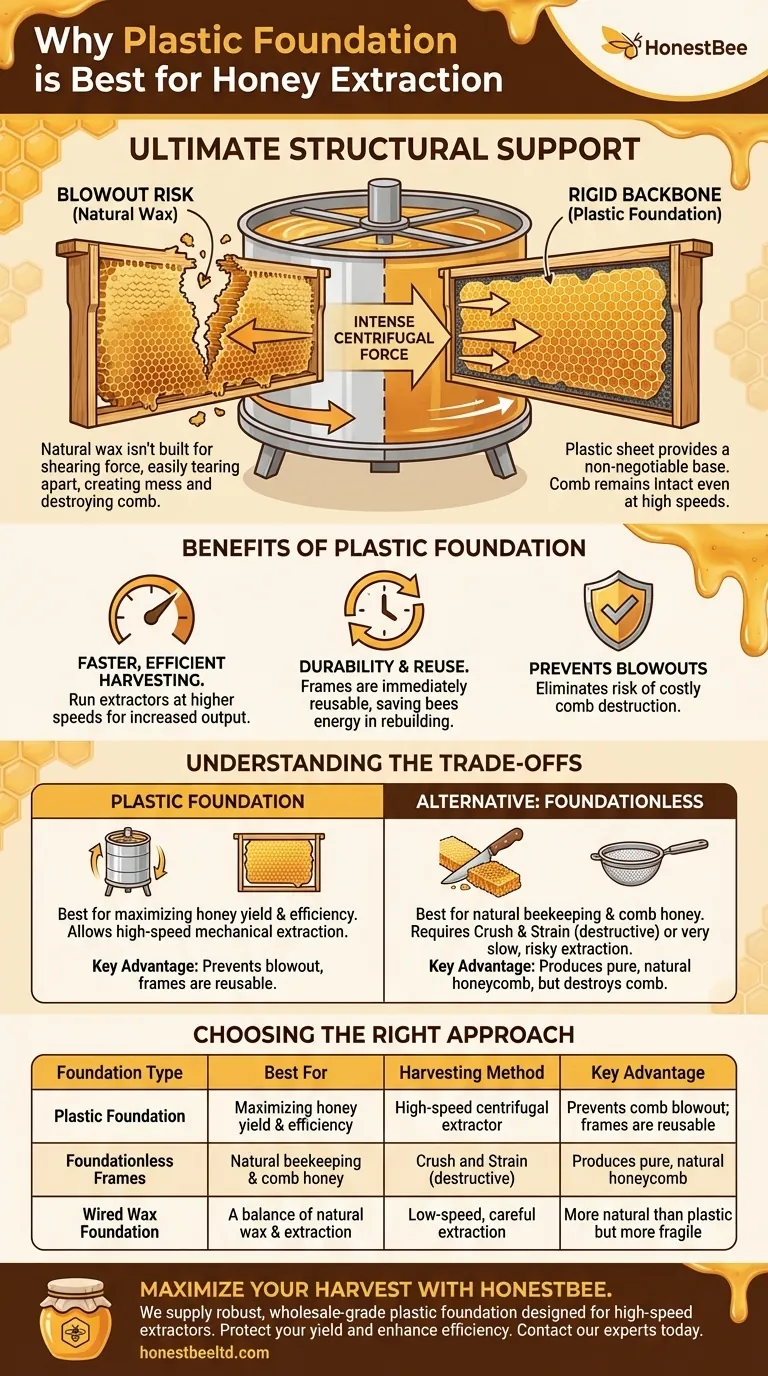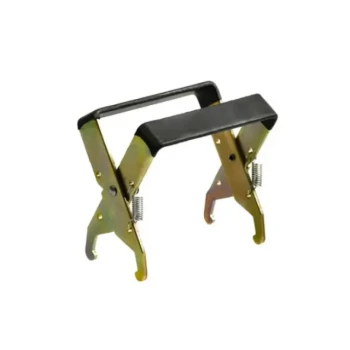Ultimately, plastic foundation is recommended for honey extraction because it provides critical structural support. The rigid plastic sheet acts as a backbone for the delicate beeswax comb, preventing it from breaking apart under the intense centrifugal force generated inside a honey extractor. This durability allows for faster, more efficient harvesting and ensures the frames can be reused immediately.
Your choice of foundation is a fundamental decision that dictates your honey harvesting method. While plastic foundation enables high-speed mechanical extraction, alternatives like foundationless frames prioritize natural comb but often require a more manual, destructive harvesting process.

The Physics of Honey Extraction
To understand why foundation is so important, you must first understand the forces at play inside an extractor. An extractor is simply a centrifuge that spins frames to sling honey out of the cells.
The Force on the Comb
A frame full of capped honey is incredibly heavy. When the extractor spins, it generates immense outward force, pulling this weight away from the center of the frame.
This force is applied directly to the wax structure of the honeycomb.
The Weakness of Natural Wax
Beeswax is a remarkable material, engineered for vertical strength to hold the weight of honey and the brood. However, it is not designed to withstand the shearing, outward force of an extractor.
Especially on a warm day when the wax is softer, this force can easily cause a "blowout," where the entire sheet of comb tears away from the frame, creating a significant mess and destroying the comb.
How Plastic Foundation Solves the Structural Problem
Plastic foundation is a simple and effective engineering solution to the inherent weakness of natural comb during mechanical extraction.
A Rigid Backbone
The plastic sheet serves as a solid, non-negotiable base. The bees build their wax cells directly onto this rigid surface.
When the frame is spun in an extractor, the centrifugal force is transferred through the wax to the plastic foundation, which can easily withstand it. The comb remains intact.
Enabling High-Speed Extraction
Because the risk of a blowout is virtually eliminated, you can run the extractor at much higher speeds. This dramatically increases the efficiency of your honey harvest, allowing you to process more frames in less time.
Durability and Reuse
Plastic foundation is far more durable than wax. After extraction, the "wet" frames can be returned directly to the hive for the bees to clean and refill. This saves the bees an enormous amount of energy, as they do not need to rebuild the comb from scratch.
Understanding the Trade-offs
Choosing plastic foundation is a practical decision, but it is not the only option. It's crucial to understand the alternatives and their implications.
The Alternative: Foundationless Frames
Some beekeepers prefer to let bees build their own comb without any foundation. This is known as "foundationless" beekeeping and results in pure, natural honeycomb.
While some experienced beekeepers successfully extract foundationless frames by spinning very slowly and carefully, it is a high-risk process. Breakage is common.
The "Crush and Strain" Method
The most common way to harvest honey from foundationless frames is the crush and strain method. As the name implies, the beekeeper cuts the comb out of the frame, crushes it to release the honey, and then strains the mixture to separate the honey from the wax.
The major downside is that this process completely destroys the comb. The bees must expend significant time and resources (consuming about 8 pounds of honey to produce 1 pound of wax) to rebuild it, which can reduce your next honey harvest.
Choosing the Right Approach for Your Apiary
Your decision should be based on your specific goals as a beekeeper. There is no single "best" method, only the one that is right for you.
- If your primary focus is maximizing honey yield and efficiency: Plastic foundation is the superior choice. Its durability is purpose-built for use with high-speed centrifugal extractors.
- If your primary focus is natural beekeeping or producing comb honey: Foundationless frames are the ideal path. You will likely use the crush and strain method for harvesting.
- If you want a balance of natural wax with extraction capability: Wired wax foundation can be a middle ground, but it remains significantly more fragile than plastic and requires more careful handling in an extractor.
Understanding this fundamental trade-off between structural durability and natural comb empowers you to select the harvesting method that best aligns with your beekeeping philosophy and goals.
Summary Table:
| Foundation Type | Best For | Harvesting Method | Key Advantage |
|---|---|---|---|
| Plastic Foundation | Maximizing honey yield & efficiency | High-speed centrifugal extractor | Prevents comb blowout; frames are reusable |
| Foundationless Frames | Natural beekeeping & comb honey | Crush and Strain (destructive) | Produces pure, natural honeycomb |
| Wired Wax Foundation | A balance of natural wax & extraction | Low-speed, careful extraction | More natural than plastic but more fragile |
Maximize the efficiency and durability of your honey harvest.
At HONESTBEE, we supply commercial apiaries and beekeeping equipment distributors with the robust, wholesale-grade plastic foundation designed specifically for high-speed extractors. Our foundations provide the critical structural backbone your operation needs to prevent costly comb blowouts and ensure frames can be reused immediately, saving your bees time and energy.
Contact our wholesale experts today to discuss how our durable beekeeping supplies can enhance your harvesting efficiency and protect your honey yield.
Visual Guide

Related Products
- Food Grade Plastic bee Foundation for Bee Frames
- Beeswax Foundation Sheets Beehive Foundation for Wholesale
- Manual Beeswax Comb Foundation Machine Wax Foundation Mill Embossing Machine
- JZBZ Type Wide Base Plastic Queen Cell Cups for Base Mounting and Queen Rearing
- Professional Long-Handled Silicone Honey Scraper for Beekeeping
People Also Ask
- How does plastic foundation differ from beeswax foundation? Choose the Best for Your Hive's Success
- Why do commercial beekeepers prefer plastic foundation? Durable, Reusable, and Cost-Effective
- What is a plastic foundation sheet? A Durable, Reusable Hive Management Solution
- Does plastic foundation affect honey quality or taste? A Practical Guide for Beekeepers
- How to get bees to use plastic foundation? Master the Wax Coating and Resource Strategy



















